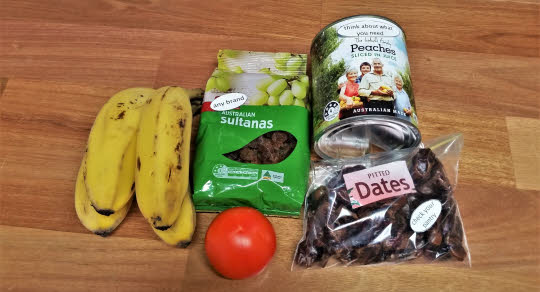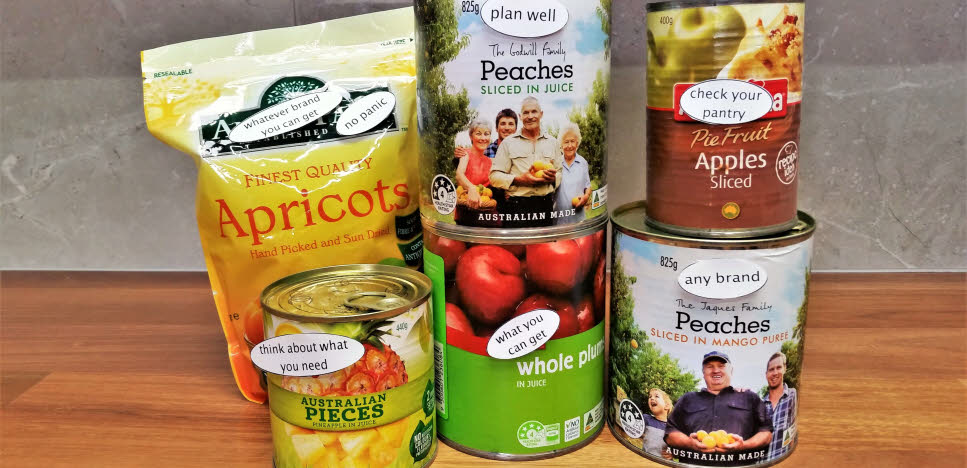Preparing for Coronavirus (Covid 19) lock down or isolation: FRUIT
 |
This is not a time to let your health slip so you need to be very flexible when shopping. This guide shows food fruit swaps that help you keep your nutrition up.
Choose the best you can from what is left on the shelves. Some swaps may simply not be possible in your area but I have included them just in case they are.
Dig in for practical tips for shopping for fruits to use during isolation or quarantine.
Be prepared because you will not be able to shop during quarantine or self-isolation. You may not be able to rely on family and friends to help.
Fruit
1. Fresh fruit may not stay fresh enough to last two weeks. Use fresh fruit up in the first week to avoid it going off.
- Buy semi-ripe bananas. They will last longer than already ripe bananas.
- Buy whole melons and pineapples rather than cut pieces. They will keep longer uncut.
- Keep fresh fruit cool and in the fridge.
- Freeze or refrigerate citrus wedges and left over fresh fruit to make juices or smoothies, if you’ve cut too much to eat at once.
2. No fresh fruit? No problem. Head for preserved fruit that is designed to last longer.
- Frozen fruit is a handy addition to cereals, drinks and desserts. The nutrition value is as good as the fresh versions.
- Dried fruit is also good on cereals, in desserts, in scones, salads and homemade breads. Dried fruit is a good planned snack food. Nutritionally, dried fruit retains all fibre and minerals and most vitamins. Dried fruit is lower in vitamin C and folate but you can get these vitamins from frozen and fresh vegetables. Avoid pressed dried fruit and fruit straps because these are loaded with added sugar.
- Fruit packed in cans and plastic jars store well and are great when added to cereals or eaten as a planned snack, dessert or blended into a smoothie drink. Like dried fruit, canned and bottled fruits contain less vitamin C and folate than their fresh counterparts but packed fruits go a long way to replace fresh fruit when it is not available. If you have a choice, select fruits packed in juice rather than syrup. Close to 60% of the contents of canned and bottled fruit is solid fruit; the balance is liquid, which you may decide not to eat. If you have no choice, fruits packed in puree or syrup are better than no fruit. Use a fork to lift out the fruit and leave the syrup behind uneaten.
- Fruit juice needs to be pure 100% juice. Long-life from the shelves in cartons or bottles makes more sense to have at hand as an emergency item than juice from the fridge. If possible, avoid fruit juice drinks because these are weak diluted juice with added sugar. They are not as good as pure juice. There is no point buying fruit cordial as you may as well be buying soft drink. Juices have all the fibre removed and are not as good as fresh, frozen, dried or preserved fruits for fibre. Many juices have vitamin C added to help preserve the juice. A 100% juice is better than no fruit at all during quarantine or self-isolation. Tomato juice sits in here as well.
3. Not a fruit eater? Have more vegetables, after all tomatoes and capsicum are considered fruits but we eat them as vegetables. I will cover this in another article.
How much to buy, swap and serve?
Packets, jars and cans vary is size and you are at the mercy of what remains in the shop. These are approximate amounts that give you a guide when shopping.
Close enough is good enough at this stage.
Check your pantry and freezer before you shop for items in bulk. You may already have enough frozen, dried and canned fruit hiding somewhere.
For one adult aim for two serves daily, where one serve equals 1 fresh fruit = 30 g dried fruit = 150 g drained fruit from jars and cans = 160 ml fruit juiceEach one of these amounts is enough fruit to last an adult 1 week:
14 pieces of fresh fruit (size of an apple, orange or banana), or
2.3 kg fresh (with edible skin) or frozen fruit. Allow 2.5 kg if the skin has to be peeled away and is not edible (e.g. banana, orange, melon), or
400 g dried fruit, or
3500 g fruit packed in cans or plastic jars. This is the total weight shown on packaging. In other words, before draining. It is not unusual for 40% of the weight to be throw-away liquid. I have allowed for that, or
2.2 L fruit juice.
Combine these in any way to make up 2 weeks worth of fruit.
two weeks, enough for one adult
Shop your pantry first. Stock spare dried and canned fruits because they last well. Any brand, any variety is fine. If you have a choice, choose fruits canned in juice rather than syrup. Reject dried fruits with added sugar. Check the ingredient list for sugars, honey and syrups. Don't worry about reading the numbers on the nutrition panel.

more example of 2 weeks worth of fruit
Here is another way of looking at how much to buy, swap and serve. Each of the following combo examples is enough to last 2 weeks for one adult:
14 pieces fresh fruit + 200 g dried fruit + 1750 g fruit packed in cans or plastic jars (total label weight)
OR
1 kg fresh (with edible skin) or frozen fruit + 600 g dried fruit
OR
400 g dried fruit + 3500 g fruit packed in cans or plastic jars (total label weight)
OR
7 pieces fresh fruit + 1.1 L juice + 200 g dried fruit + 1750 g fruit packed in cans or plastic jars (total label weight)
OR
1.6 L juice + 300 g dried fruit + 2000 g fruit packed in cans or plastic jars (total label weight).
These amounts might sound a lot but once spaced out across a fortnight, they are just enough.
By spreading the shop across dried, canned, frozen and fresh, rationing has less of an impact. It may take a few shopping trips to buy enough for a large household.
When choice is limited and food is rationed, close enough is good enough when it comes to amounts. We are at the mercy of supplies and fellow shoppers.
